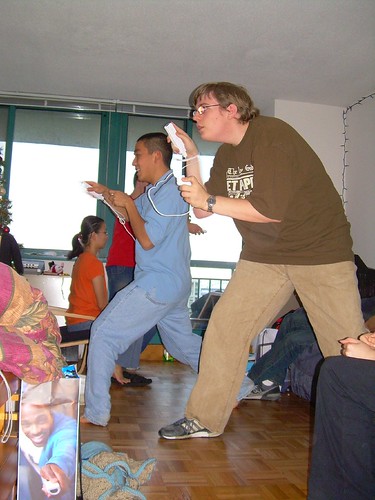Wednesday, January 27, 2010
Medical News: Multiple Benefits Seen for Exercise in Seniors - from MedPage Today
Since encouraging regular physical activity in the most sedentary adults fosters long lasting benefits, healthcare providers as well as family and friends often hope to find ways to promote change.
Changing various health behaviors occurs through a process. Many theories of health behavior change offer insight into ways to maximize success for those attempting to alter behavior. One theory in particular, the Transtheoretical Model (Stages of Change), explains behavior change as a journey through various phases of awareness and action. Each phase leads to increased awareness of the need for change. Those along the journey of change gain confidence in their ability to make and maintain the desired modification.
Nintendo Wii activities play an important role as a fun way to bring exercise into an individual’s daily schedule. Individuals in the "pre-contemplation" stage, when exposed to activities in Wii Sports and Wii Fit, may increase their awareness of both their need for exercise and their need to improve endurance and balance. This awareness may help them move to the "contemplation" stage. Since Wii Sports and Wii Fit bring a fun factor into exercise, individuals may decide that moving more can be enjoyable. In fact, they may begin to view physical activity while using the Wii not as exercise but as just a fun activity, helping the individual move on to the "preparation for action" stage. Furthermore, Wii Fit activities provide great feedback and can be played together with others (two aspects of other theories of learning and change). As a result, individuals may begin to engage regularly in the use of Wii Sports and Wii Fit activities. Once these individuals are well entrenched in this "action" stage, the individual is well on their way to a less sedentary lifestyle.
Ford Vox, MD explains however, that activities offered through Nintendo Wii games should not be used as a replacement for the actual sport. But for those individuals who have a sedentary lifestyle, not participating regularly in any physical activity, Wii offers a motivating vehicle to change.
Thursday, March 19, 2009
The Wii can fight Childhood Obesity
Wednesday, October 8, 2008
Wii in Health Promotion
A recent vacation opportunity brought to light other clinically relevant uses of the Wii. The Wii can play a motivating role in Health Promotion and Lifestyle Modification across all ages. For many who have a more sedentary lifestyle, the Wii proves to be useful tool in encouraging change. The Wii stimulates those who may usually choose to only watch sports, to get up (or remain seated) and swing the remote at the tennis ball, the golf ball or the baseball. Others swing the remote to bowl or box.
In the school setting, students who might usually shy away from physical education (PE) classes rush to sign up for PE revolving around Wii Sports and other Wii programs. Teachers have found that the students who are reluctant to play team sports are more than willing to get out of their desks for some friendly Wii competition. The students like the feedback Wii provides and are motivated by the improvement that the Wii makes readily visible.
In the clinic setting, the Wii has an application in Health Promotion. Researchers in the area of Fall Prevention (Lachman, M., Howland, J.,& Tennstedt, A.,1998) have identified a sedentary lifestyle as a primary risk factor for falls. In older adults, a sedentary lifestyle and a fear of falling (Edelberg, 2001) often go hand in hand, creating a reciprocal nature among fall risk factors in the elderly population. Using Wii as a therapeutic activity with elders allows the clinician to work towards goals such as increasing standing and activity tolerance, improving dynamic balance and reducing fear and anxiety. The fun nature of Wii along with the built-in reinforcement of improved scores encourages and motivates elders to be more active and engaged in therapy.
Another great therapeutic use of Wii is in Lifestyle Modification Programs. Lifestyle Modification Programs help clients struggling with obesity, type 2 Diabetes, or other chronic conditions to implement changes in daily routines, reducing disease burden. Initially, the Wii gently introduces increased physical activity into the daily schedule. For those participants with a history of computer gaming, the Wii allows them the familiar pleasure of gaming while increasing physical activity. Wii also encourages social interaction and creates opportunity for community building through the creation of bowling leagues and baseball teams.
Exercising in the virtual environment created through the Wii should not be considered a replacement for exercise in the real world, but Wii Gaming can be used effectively to provide additional activity throughout the day. The Wii may help those who are extremely sedentary to take initial steps toward increasing activity. By increasing the level of daily activity, participants may gain strength, endurance and improved balance, leading to improved well-being.
References:
Edelburg, H. (2001). Falls and function: How to prevent falls and injuries in patients with impaired mobility. Geriatrics. 56(3). 41-45.
Lachman, M., Howland, J.,& Tennstedt, A.(1998). Fear of falling and activity restriction: The survey of activities and fear of falling in the elderly (SAFE).Journals of Gerontology: Series B: Psychological Sciences and Social Sciences. 53B(1). 43-50.



